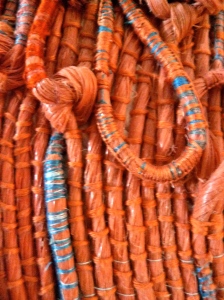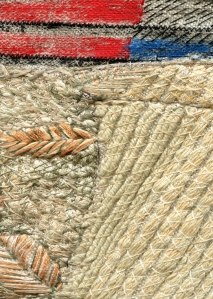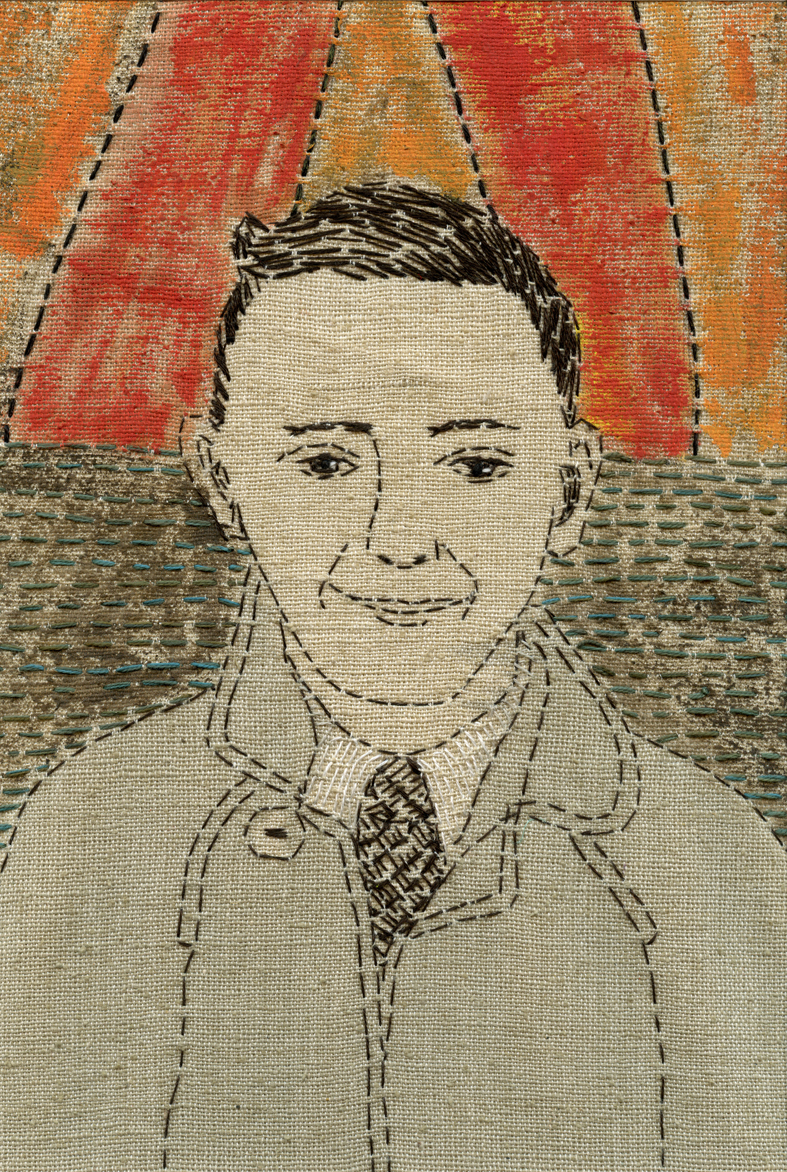There are so many great embroidery stitches so why do I use so few of them?
The answer is that the ones I do use are so versatile. These are my 5 favourites.
1 • Running Stitch
Possibly the most useful of them all, Running Stitch is a basic, straight stitch that can be used in so many ways. By varying the length of the stitch and the thickness of the thread so many different effects can be achieved. I use it most frequently for drawing portraits using just a single strand of stranded cotton thread.This stitch is also good for hair as just changing the direction of the stitch can give a wave or a curl effect. Patterns can easily be created on clothing by using the stitch in different directions to draw squares, stripes, triangles and zigzags. Here are some examples of how I have used running stitch.
Another of my frequently used straight stitches is Arrowhead Stitch. I often use this simple straight stitch to form a ‘mock’ herringbone pattern which evokes the look of a woven herringbone tweed fabric. This is achieved by combining 2 different colours of thread in the same needle. It’s so useful for making patterns on coats and jackets as seen below.


3 • Cross Stitch
More recently I have been using a lot of Cross Stitch in a free, non-formal way to create patterns on dresses and also a colour filling stitch on my Graffiti series. Vary the size and of the stitch and the thickness of the thread for for more variety of finished surfaces.




4 • Darning Stitch ( Needleweaving)
Darning Stitch or Needleweaving as I prefer to call it is a great stitch effect for drawing house bricks. A long straight stitch forms the warp for the area you want to fill and then using the needle to weave your thread in and out of the warp stitch to form the weft building it up until the whole area is filled.

5 • Couching
This versatile stitch is used to hold a thicker thread onto a background by stitching it down to form shapes or to fill an area. Vary it by using a different colour, a cross stitch or an angled stitch on the top instead of a straight stitch.
Enjoyed seeing my favourite stitches? Let me know what yours are.









It’s so interesting to see how you use simple stitches to such a great effect!
Thanks Meta. At Goldsmiths college, London I was taught by the late great Constance Howard and I have always tried to follow her advice which was that you don’t need to know lots of stitches but you just need to use the ones you do know to your best ability.
Thank you, I’ll do that, I’ve only just entered the world of embroidery by taking Sian Martin’s Distant Stitch course, so I’m open to any advice, especially when it comes from you or the famous Constance Howard!
Thank you for simplifying the art of embroidery. As a left handed artist exploring this new medium, I find it difficult to learn from pics and tutorials from right handed artists. Any suggestions? Your work is both beautiful and inspiring. Thank you for sharing.
Regards,
Natalie Denomme, Belgium
I am also left handed Natalie and that’s probably the main reason I only use a few different stitches in my work. I suggest that you try experimenting on small samples to learn what the stitches can do rather than launching straight in to a finished piece.
On my own online courses I make sure to have left handed as well as right handed demos for the stitches. If you are interested in finding out when the next courses are released then you can sign up to find out here: https://training.textileartist.org/courses/
I’d suggest that Exploring texture and pattern is a good starting point.
But you only need a few stitches to get you going. Most of my own work is made just using running stitch and backstitch in an informal way. There are left handed demos out there if you search for them but I haven’t used them myself so I can’t recommend any specific ones but Google ‘left handed embroidery demos’ and a few will come up. Hope that helps.
Thank you for your response. I look forward to hearing about your new online courses. Kind Regards,
Natalie Denomme
Very interesting! I absolutely love your work!
Thanks, Judy
You draw so beautifully with your ‘simple’ stitches. Like you I find running stitch immensely versatile, and use it almost exclusively. The other stitch I sometimes use is seed stitch.
Yes, seed stitch is also a great stitch. Another of my favourites.
Recently I discovered back stitch, which I used spaced out, and love the subtle difference from running stitch that it gives. The individual stitches are … so individual … they enclose themselves, rather than continuing to be part of the thread. Soon, perhaps today?, I’ll try some experiments with different spacings and different kinds and thicknesses of thread.
Sounds like a good idea Margaret, I had forgotten back stitch. I’ll take another look at it. You are right you do get a different type of line than the one you get with a running stitch. Being left-handed my back stitch is also much wonkier! That in itself gives endless possibilities for an interesting finish.
Good read Sue! Thank you, I agree, those stitches are great to use and can look so different if varied in size, length, etc.
Thanks, Lucy. I hope you are still doing lots of stitching yourself.
I am Sue, it’s slow but sure! Your work continues to inspire me 🙂
I find that Straight stitch in it’s various guises meets all my needs. Maybe I should be more adventurous? I really liked your work at the Mall Galleries and it has inspired me to experiment with adding textured paint to dyed fabric, alongside stitch. I have dyed some fabric ready to experiment. I hope to post the results on my blog in due course http://www.textilesnippets.blogspot.co.uk
Straight stitch is definitely my most used stitch but it is good to experiment once in a while. Hope your experiments go well. Let me know when you update your blog so I can check out your results.
Sue,
Here’s the link to my very basic experiment http://textilesnippets.blogspot.co.uk/2013/02/experimenting-with-acrylics-on-fabric.html
I’m encouraged to do more of it – so that’s good. Thanks for the inspiration.
Marian
Thanks Marian. Interesting results. Keep on experimenting!
Great post! Your choice of stitches is very close to me, but I have a weak point for blanket stitch. And I will always find a way to include it somewhere.
Blanket stitch is a great stitch.I used to use that a lot. Thanks for reminding me of that one.
coming late to stitching i do find it hard sometimes to work out if I am mark making, or colouring, or drawing, or if I should be stitching at all. I tend to resort to running stitch in the end tho I do like lock stitch. http://www.glengerrard.com
I think of stitching as drawing and mark making with thread instead of a pencil. To me there is no difference. It’s just my chosen medium. I sometimes think I was born with a needle and thread in my hands although I hate dressmaking with a vengeance. I just have no patience for it.
Lockstitch ? I assume by machine? Well, free machine stitch is extremely versatile and I have used it a lot in the past. I like to combine hand and machine stitch to give a different mix of textures. Also lockstitch is great if you mix the threads in your machine needle and leave the eye to mix the colours.I seem to be going through a hand stitch period at the moment though.
I think of hand-stitching as drawing too. In fact, I just taught myself this year by using YouTube so I could teach it in my high school art class. I mainly use the back stitch. Thanks for the inspiration!
A bog fan of a running stitch myself, I am amazed by your work. You put it to such great use!
Thanks a lot Raphaele
Amazing and inspired – you are a very talented artist. Glynn
Thanks Glynn. Happy stitching.
Your art takes my breath away! I love it. Thanks for sharing your techniques.
Thank you for reading
All the stitches are stunning and effective. I have 2 indian outfits (6yds sarees) and few outfits from India and they call it kantha work. The they used is silk hand/ vegetable dyed.
Regards Kundan
I love kantha work. It’s very simple, effective and beautiful.
Pingback: 63 – A Self-Portrait – Work in Progress | womanwithafish
You are an amazing artist!!!
I am really enjoying this page. Thank you. I have always been a fan of needlework, including embroidery, crewel, black work, etc. A special passion is crazy quilts due to the variety of stitching but this is very much making me think about these as a possible gift item. Thank you for the inspiration.
Pingback: Månadens måste juli: brodera ett porträtt | broderamera
You are extremely talented. I enjoyed looking at all your work. Thank you for sharing.